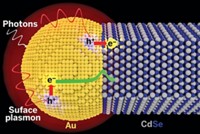Advertisement
Grab your lab coat. Let's get started
Welcome!
Welcome!
Create an account below to get 6 C&EN articles per month, receive newsletters and more - all free.
It seems this is your first time logging in online. Please enter the following information to continue.
As an ACS member you automatically get access to this site. All we need is few more details to create your reading experience.
Not you? Sign in with a different account.
Not you? Sign in with a different account.
ERROR 1
ERROR 1
ERROR 2
ERROR 2
ERROR 2
ERROR 2
ERROR 2
Password and Confirm password must match.
If you have an ACS member number, please enter it here so we can link this account to your membership. (optional)
ERROR 2
ACS values your privacy. By submitting your information, you are gaining access to C&EN and subscribing to our weekly newsletter. We use the information you provide to make your reading experience better, and we will never sell your data to third party members.
Energy
Probing Nanotube Photochemical Properties
ACS Meeting News: Study calls into questions key assumptions about using nanotubes in solar cells
by Mitch Jacoby
March 29, 2011

Researchers in South Korea have obtained data that questions key assumptions about the photochemical properties of semiconductor nanotubes.
The work suggests that seemingly promising strategies for using nanotubes to boost the performance of solar cells and photocatalysts based on titanium dioxide, a well-studied candidate for those applications, may be less effective than expected. The study also identifies directions for follow-up investigations.
The study was presented at the American Chemical Society meeting in the Division of Fuel Chemistry at a symposium on solar energy conversion and has just been published in the Journal of Physical Chemistry C (DOI: 10.1021/jp201215t).
Compared with pure TiO2 nanoparticles, TiO2 nanotubes and nanotubes made from TiO2 hybridized with iron oxide are predicted to exhibit enhanced photo properties as a result of increased light scattering from the tubes' internal surfaces and broader light harvesting capabilities of the hybrid.
Tae Hwa Jeon and Hyunwoong Park of Kyungpook National University in Daegu, and coworkers, examined that prediction for the iron oxide-based nanotubes by preparing unhybridized TiO2 nanotubes and hybridized nanotubes with nanocrystalline hematite (α-Fe2O3) particles deposited on their rims or filling the nanotubes completely. The team used those materials as well as TiO2 nanoparticle films and other control samples to measure photocurrents generated in electrolyte solution under standard conditions. They used the same materials in a separate set of experiments to measure the rate of photocatalytic decomposition of phenol.
The key result reported by the group is that nanotubes containing hematite—especially rim-coated nanotubes, in which the interior tube surface remains exposed and available to mediate reactions—are far less active photochemically than uncoated samples.
"It's a surprising result that suggests that the interior surface of these nanotubes is not as photoactive as people would think," says Chad D. Vecitis, a Harvard University professor of environmental engineering. He adds that the work is likely "to bring up a new discussion and help push investigations in a direction that will provide answers."
Park proposed that the unexpectedly low activity could result from hematite-induced charge recombination, a process in which excitations induced by photons are quickly quenched by charge transfer at the hematite-nanotube interface. He added that a telling follow-up experiment, one that would home in on the photoactivity of the nanotubes' internal surfaces, would be to repeat the measurements—this time using nanotubes that have been selectively hybridized with photoinactive materials.




Join the conversation
Contact the reporter
Submit a Letter to the Editor for publication
Engage with us on Twitter